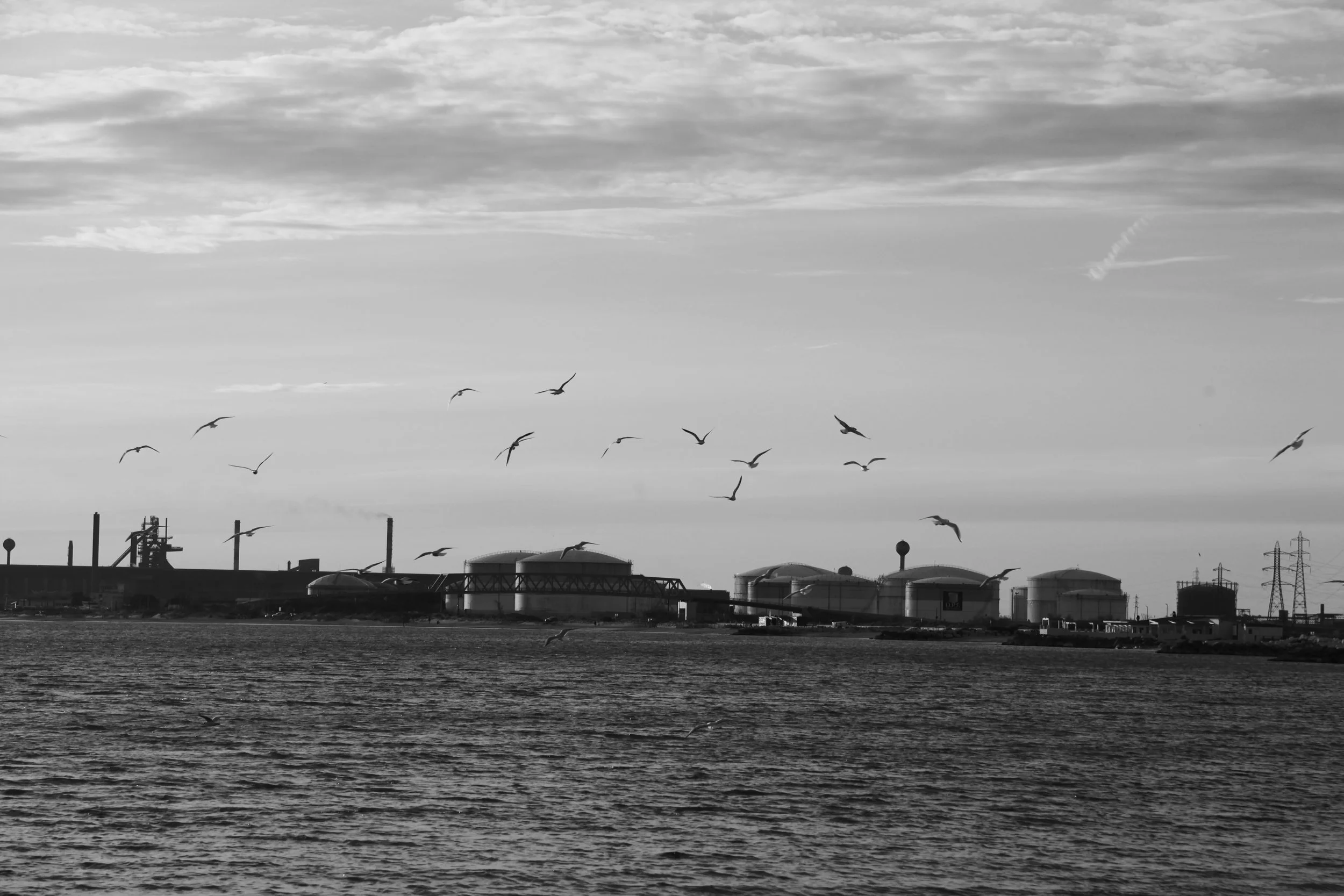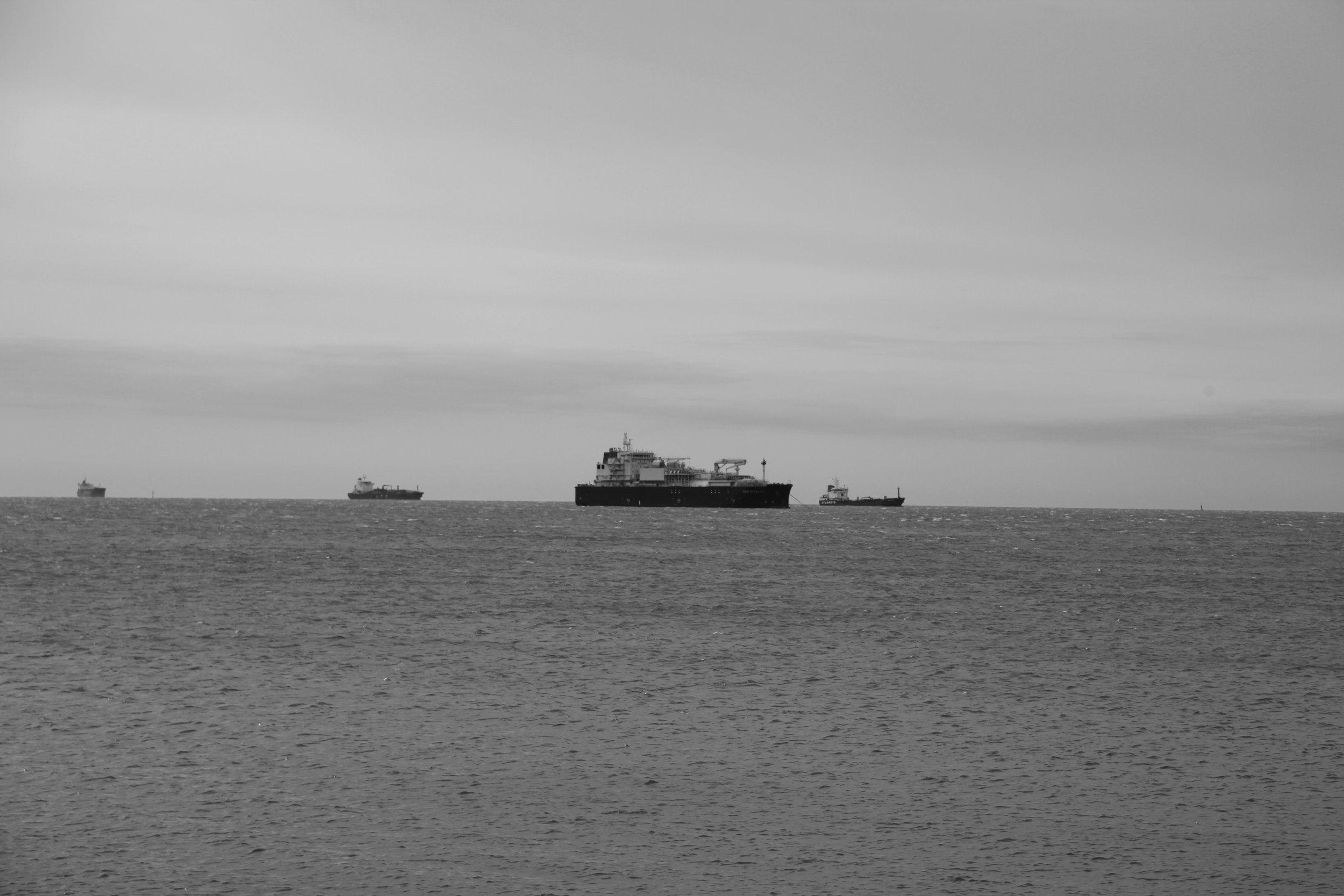II. Changed Coasts
Fos-sur-Mer is a town of approximately 15,000 residents on the Mediterranean coast of France, about 50km northwest from Marseille and bordering the Rhône River Delta to the east.
The Gulf of Fos harbors one of France’s largest industrial complexes, where major activities include steel production, fuel importation and oil refining. On February 18, 2022, a large LNG tanker, the Hellas Diana, arrived in the Gulf of Fos to offload its cargo containing fracked American natural gas. It became the 22nd LNG tanker to deliver natural gas from the United States to France already in the new year. American LNG tankers had been delivering to France since 2018, but this fact has gone largely unreported in the French media and indeed by the French government itself. The practice of fracking for commercial or research purposes is forbidden in France.
France was one of the first countries to begin importing LNG in the 1960s which today represents a significant share of the country’s natural gas imports. Natural gas is the third largest source of energy in France behind nuclear power and oil, and represents approximately 15.8% of total French energy consumption according to the French Ministry of the Environment’s most recent assessment for 2020. The largest exporters of natural gas to France were Norway (37%) and Russia (17%).
Russian natural gas flows into France via the European pipeline network as well as from LNG tankers to the ports of Dunkerque and Montoir-de-Bretagne since 2017. The French energy giant Total describes itself as “the second-largest global private LNG player” and holds a 20% stake in Yamal LNG, Russia’s major LNG export project connecting to the European market, as well as 10% in the nearby developing Arctic LNG II project. French gas giant Engie also invests globally and is a significant shareholder in the Nord Stream 2 pipeline (for subsequent clarity, Engie was formerly known as GDF Suez between 2008-2015, which had been formed in a merger involving French national gas company GDF and the multinational Suez).
It took many years and massive investment for ships such as the Hellas Diana to be able to operate in the Gulf of Fos. The project faced strong opposition as the environmental impacts of the terminal construction became more apparent. Local citizens became concerned in the autumn of 2002 when GDF and their subsidiary Elengy filed for the construction of the new LNG import terminal Fos Cavaou. It would add major import capacity to the region, already supplied by the smaller terminal Fos Tonkin.
Fos-sur-Mer, February 19, 2022
Daniel Moutet, president of the Association for the Defense and Protection of the Coast of the Gulf of Fos (ADPLGF) explains how his organization started and what changes the construction of the LNG import terminal Fos Cavaou brought. Following the public meeting in the fall of 2002, he was part of the founding group of ADPLGF and led an extensive legal battle against GDF/Elengy to obtain environmental improvements during the LNG terminal construction process and mitigate negative long-term impacts.
Interview with subtitles below
The first part of the case was not judged for several years, during which time the terminal was constructed. Meanwhile, the Association continued to follow its suit to resolve major concerns including nonstop construction traffic along the beach, advocating the opening of an emergency bridge from the site, the maintenance of a dock for ships in distress (which was originally supposed to be removed) and reducing the size and increasing the solidity of the gas holding tanks (the area sits near a seismic fault). Due to the studies led by ADPLGF, the prefect (regional governor) ordered GDF/Elengy to keep its holding tanks at a smaller size and with reinforced construction standards, and the dock for ships in distress was maintained. In 2009, when the terminal was already constructed, GDF/Elengy lost their first court case concerning the construction process. After appealing the decision, the company lost again approximately a year later. ADPLGF successfully negotiated to obtain a long-term lease of the Cavaou Beach and the closure of the beach road to industrial traffic with the opening of the emergency bridge.
Once the terminal started operations, it became clear that there was damage to the local ecology of the gulf caused by the heating and chlorination of sea water which was pumped to regasify the LNG. Two local power stations also use the gulf’s water as a cooling fluid. Daniel Moutet explains,
“…the sea water, the gulf were sacrificed. We found out some years later about the disappearance of mussels, the young developing mussels which no longer appeared in the gulf there... there was also no more sea grass directly where the water came out, where it was reheated and chlorinated. That clearly left its mark.”
Moutet credits GDF/Elengy for honestly working to solve the problem and finding a better method for reheating the gas by developing a replacement product that doesn’t contain chlorine. Following years of court battles, he does not see the energy company as an adversary. He emphasizes,
“We were not against GDF/Elengy. We were against the location (of the terminal).”
Since its success in obtaining concessions from GDF, the Association has launched other major actions with strong support from the local government. In the past years it opposed the construction of the incinerator for Marseille’s municipal waste in Fos-sur-Mer and has worked to better air quality and reduce pollution. The town’s inhabitants have been subjected to decades of exposure to industrial pollutants which are responsible for abnormally high rates of diseases including cancers which have caused premature deaths in the population. The scientific research organization Institut écocitoyen was started in 2010 and has been involved in a number of studies of pollution impacts around Fos-sur-Mer. These have been recognized by the French government which also conducted its own study affirming regional air pollution impacts in 2018. Drone technology is currently being used to amass additional data of industrial pollution around the gulf through a project led by the ADPLGF with cooperation from the Institut écocitoyen.
Moutet recognizes clear benefits from natural gas which pollutes much less when burned compared to other forms of industrial combustion present in Fos-sur-Mer. He worked for 32 years at the coal import dock across from today’s Fos Cavaou terminal and knows the impacts of atmospheric pollution from the adjacent industrial plants firsthand, including from the ArcelorMittal steel mill and nearby petrochemical refinery. In addition, he sees LNG as a fuel of the future for ships, which offers a much cleaner combustion than the fuel oil (“bunker fuel”) commonly used on large seafaring vessels. Air pollution from shipping is associated with thousands of premature deaths each year in exposed regions worldwide, and the net CO₂ from international shipping would rank comparably among the top-ten emitting countries globally.
Fos-sur-Mer, February 19, 2022
The Cavaou Beach in Fos-sur-Mer. The beach remained opened due to the legal success of the ADPLGF. Fos-Sur-Mer, February 20, 2022
Fos-sur-Mer, February 19, 2022
Moutet doesn’t see the benefits of natural gas as being universal across the entire global supply chain. He notes a change in the cargoes coming into Fos Cavaou,
“And now there is the infamous American gas, it’s what they call shale gas. At first they didn’t want to import it, but now they’re happy to have it.”
The issue of importing fracked natural gas into France was opposed in 2016 by then French Minister of the Environment Ségolène Royal, but no legal mechanism was developed to prevent the paradox of importing a product banned for extraction on French soil. Barriers included World Trade Organization rules which ensure unrestricted competition regardless of environmental impacts in the exporting country according to a source quoted in Le Monde. In 2014, Engie made a deal with American exporter Cheniere Energy for “up to twelve cargoes per year,” while EDF (Électricité de France, then-owner of the nascent Dunkerque terminal) entered a similar long-term contract with the same supplier in 2014, as reported in the same article in Le Monde. This was supplemented by a smaller short-term contract between EDF and Cheniere Energy in 2015.
The issue largely disappeared from the French media until Le Monde reported in 2020 that the French government had a blocked multibillion euro LNG import contract between Engie and American natural gas exporter NextDecade based on environmental concerns regarding fracking. This was followed in 2021 by a successful smaller €1.67 billion contract signed between Engie and Cheniere Energy, without the prior knowledge of the French government (23.6% shareholder of Engie) according to Le Monde. Engie was not required to disclose the 2021 contract for approval by the French government due to the relatively smaller volumes of natural gas involved compared to the 2020 failed deal, according to the report. The newspaper also claims to have received information that Engie passed an internal memo instructing insiders to avoid spreading any publicity of the contract. While Le Monde provides detailed and critical reporting on the “secret” 2021 contract, they do not provide context regarding how much France is already importing fracked gas from the United States.
The Hellas Diana offloading LNG from Corpus Chrisi, Texas, United States in Fos-sur-Mer, February 19, 2022
Fos-sur-Mer, February 19, 2022
American LNG has been entering French ports since 2018 according to the United States Department of Energy, reaching a monthly high of 1,023 million cubic meters in April 2021 before approaching record levels again in December 2021. The first LNG tankers to leave the United States for French import terminals were the Golar Snow (October 17, 2018) and the Clear Sky (October 22, 2018). By the end of February 2022, more than 140 LNG tankers have entered French ports with American LNG cargoes. Over a third of these transits were in 2021 alone: 52 vessels arrived from United States LNG export terminals delivering a total of 4,836 million cubic meters of natural gas.
French media outlets largely neglected to cover the arrival of fracked American natural gas in France in 2018 or the growth in trade which followed until recent developments in 2020 and 2021. It appears that only the Observatoire des multinationales covered the subject of the first cargoes to arrive, with a detailed article from March 2019. France also gains the distinction of welcoming the world’s first-ever tanker delivery from the newly operational Calcasieu Pass LNG terminal in Louisiana with the arrival of the tanker Yiannis in the port of Dunkerque on March 16, 2022.
The United States is fast solidifying itself as a leading exporter of natural gas to France, yet the French government makes no mention of this in their annual energy report. Norway (36%), Russia (17%), Algeria (8%), the Netherlands (8%), Nigeria (7%) and Qatar (2%) make their 2020 rankings. American fracked gas exports were possibly classified within the 23% remaining share of natural gas imports:
“… from other countries, of which a part includes gas in which the area of production cannot be traced (as it is bought in the Northwest European markets for example). Their development lends itself to a diversification of supplies made possible through the importation of liquified natural gas (LNG).”








